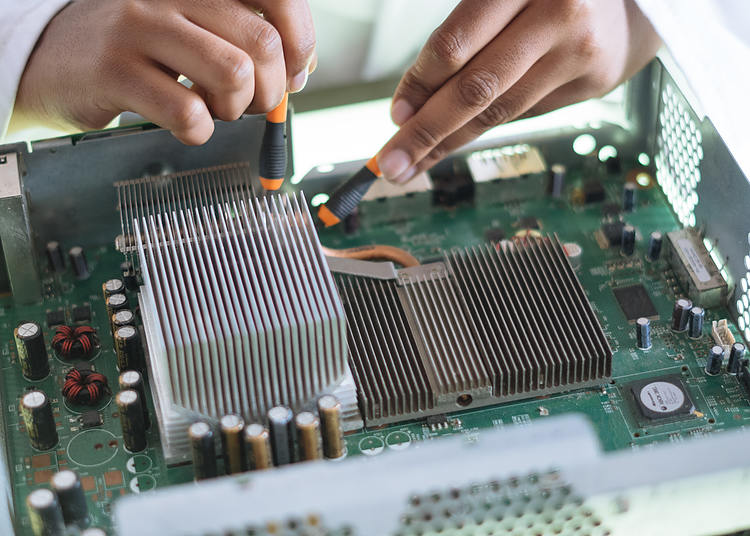- SMCI experiences its worst plunge since April 19.
- Operating margins slim down in recent quarter, shortages hurt profits.
- Management is guiding for between $26B and $30B in FY 2025 revenue.
- Super Micro stock is trading 58{721fc769be108e463fe4e33f629fb22fe291c423a7a69eaaf65dcb28e9b05dea} off its March 8 high.
Super Micro Computer (SMCI), the best-performing S&P 500 stock in the first half of the year, has tumbled some 16{721fc769be108e463fe4e33f629fb22fe291c423a7a69eaaf65dcb28e9b05dea} on Wednesday following a worse than expected fiscal fourth-quarter result. The designer of state-of-the-art server software, server hardware and cooling solutions has seen its fortunes explode higher in recent years on the back of the Nvidia-led (NVDA) artificial intelligence (AI) revolution.
But late Tuesday, Super Micro posted adjusted earnings per share (EPS) of $6.25, $1.89 below Wall Street consensus as well as the previous quarter’s $6.65. Revenue of $5.31 billion, however, was largely in-line with projections and rose 144{721fc769be108e463fe4e33f629fb22fe291c423a7a69eaaf65dcb28e9b05dea} from a year earlier.
The Street at large continues to recover from its bashing last Friday and again on Monday, which saw massive selling across industries and markets. Both the S&P 500 and NASDAQ Composite have added more than 1{721fc769be108e463fe4e33f629fb22fe291c423a7a69eaaf65dcb28e9b05dea} at the time of writing.
Super Micro Computer earnings news
Super Micro’s CEO, Charles Liang, blamed the earnings miss on a shortage of components and lighter operating margins.
“Our Q4 operating margin is 7.8{721fc769be108e463fe4e33f629fb22fe291c423a7a69eaaf65dcb28e9b05dea}, which is lower than what we expected due to the higher mix of hyperscale datacenter business and expedited costs of our DLC liquid cooling components in June and September quarters,” Liang said during the earnings call. “Some key new components’ shortage delayed about $800 million of revenue shipments to July, which lowered our EPS for June and will be recognized in our September quarter.”
Management said that net revenue would arrive between $6 billion and $7 billion during the present quarter, which ends in September. That range was well above the consensus choice of $5.45 billion, so it seems like the company’s prospects are not slowing down.
More shockingly, Liang and company gave guidance for full fiscal-year 2025 of between $26 billion and $30 billion. Fiscal 2024 saw total sales of just under $15 billion. In other words, management expects sales to nearly double within 12 months.
Adjusted EPS next quarter also looks quite healthy in the $6.69 to $8.27 range. Management also said they would undertake a 10-for-1 stock split in October.
AI stocks FAQs
First and foremost, artificial intelligence is an academic discipline that seeks to recreate the cognitive functions, logical understanding, perceptions and pattern recognition of humans in machines. Often abbreviated as AI, artificial intelligence has a number of sub-fields including artificial neural networks, machine learning or predictive analytics, symbolic reasoning, deep learning, natural language processing, speech recognition, image recognition and expert systems. The end goal of the entire field is the creation of artificial general intelligence or AGI. This means producing a machine that can solve arbitrary problems that it has not been trained to solve.
There are a number of different use cases for artificial intelligence. The most well-known of them are generative AI platforms that use training on large language models (LLMs) to answer text-based queries. These include ChatGPT and Google’s Bard platform. Midjourney is a program that generates original images based on user-created text. Other forms of AI utilize probabilistic techniques to determine a quality or perception of an entity, like Upstart’s lending platform, which uses an AI-enhanced credit rating system to determine credit worthiness of applicants by scouring the internet for data related to their career, wealth profile and relationships. Other types of AI use large databases from scientific studies to generate new ideas for possible pharmaceuticals to be tested in laboratories. YouTube, Spotify, Facebook and other content aggregators use AI applications to suggest personalized content to users by collecting and organizing data on their viewing habits.
Nvidia (NVDA) is a semiconductor company that builds both the AI-focused computer chips and some of the platforms that AI engineers use to build their applications. Many proponents view Nvidia as the pick-and-shovel play for the AI revolution since it builds the tools needed to carry out further applications of artificial intelligence. Palantir Technologies (PLTR) is a “big data” analytics company. It has large contracts with the US intelligence community, which uses its Gotham platform to sift through data and determine intelligence leads and inform on pattern recognition. Its Foundry product is used by major corporations to track employee and customer data for use in predictive analytics and discovering anomalies. Microsoft (MSFT) has a large stake in ChatGPT creator OpenAI, the latter of which has not gone public. Microsoft has integrated OpenAI’s technology with its Bing search engine.
Following the introduction of ChatGPT to the general public in late 2022, many stocks associated with AI began to rally. Nvidia for instance advanced well over 200{721fc769be108e463fe4e33f629fb22fe291c423a7a69eaaf65dcb28e9b05dea} in the six months following the release. Immediately, pundits on Wall Street began to wonder whether the market was being consumed by another tech bubble. Famous investor Stanley Druckenmiller, who has held major investments in both Palantir and Nvidia, said that bubbles never last just six months. He said that if the excitement over AI did become a bubble, then the extreme valuations would last at least two and a half years or long like the DotCom bubble in the late 1990s. At the midpoint of 2023, the best guess is that the market is not in a bubble, at least for now. Yes, Nvidia traded at 27 times forward sales at that time, but analysts were predicting extremely high revenue growth for years to come. At the height of the DotCom bubble, the NASDAQ 100 traded for 60 times earnings, but in mid-2023 the index traded at 25 times earnings.
Super Micro Computer stock forecast
SMCI shares were already trending below their 200-day Simple Moving Average (SMA), so shareholders can’t say they weren’t warned. If there is any hope for serious support, it may be the $467.22 level formed by the 261.8{721fc769be108e463fe4e33f629fb22fe291c423a7a69eaaf65dcb28e9b05dea} Fibonacci Retracement. When SMCI rallied hard in late January that it where it discovered brief consolidation before exploding higher.
The 200-day SMA near $700 and the 161.8{721fc769be108e463fe4e33f629fb22fe291c423a7a69eaaf65dcb28e9b05dea} Fibo at $656 make that the region to overcome in order to put an end to the downtrend. Wednesday’s plunge was the worst performance since April 19’s 23{721fc769be108e463fe4e33f629fb22fe291c423a7a69eaaf65dcb28e9b05dea} slide, but the massive revenue guidance should help the share price heading into November earnings, so now may be a great time for entry.
SMCI daily chart



